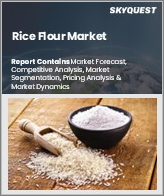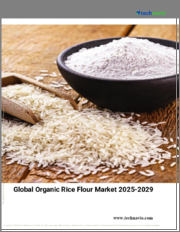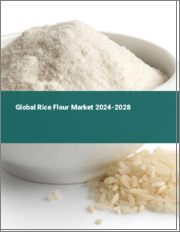
|
시장보고서
상품코드
1453969
쌀가루 시장 예측(-2030년) : 유형별, 곡물 유형별, 유래별, 판매채널별, 용도별, 지역별 세계 분석Rice Flour Market Forecasts to 2030 - Global Analysis By Type, By Grain Type, Nature, Sales Channel, Application and By Geography |
||||||
Stratistics MRC에 따르면 세계의 쌀가루 시장은 2023년에 12억 달러를 차지하고 예측 기간 중 CAGR은 6.5%로 성장하며, 2030년에는 19억 달러에 달할 전망입니다.
쌀가루는 도정된 쌀알을 곱게 갈아 만든 것입니다. 쌀가루는 밀가루를 대체할 수 있는 글루텐 프리 대안으로 제빵, 요리, 음식의 걸쭉함 등 다양한 요리에 일반적으로 사용됩니다. 쌀가루는 백미가루, 현미가루 등 다양한 유형이 있으며, 각기 다른 맛과 질감을 가지고 있으며, 다양한 레시피와 음식 취향에 적합합니다.
FAO에 따르면 인도는 IR 64, CR 2301, Kudrat 5 등 고매출 쌀 품종을 재배하고 있으며, 2020년 쌀 생산량은 1억 7,830만 톤에 달할 전망입니다. 이는 세계 생산량의 11.0% 이상을 차지하는 중국에 이어 세계 2위의 쌀 생산국입니다.
글루텐 프리 제품에 대한 수요 증가
글루텐 프리 제품에 대한 수요 증가는 쌀가루 시장의 중요한 촉진제가 되고 있습니다. 글루텐 불내성, 셀리악병, 글루텐 과민증에 대한 인식이 높아짐에 따라 소비자들은 밀가루를 대체할 수 있는 식품을 적극적으로 찾고 있습니다. 쌀가루는 훌륭한 글루텐 프리 대용품으로 글루텐 관련 질환을 앓고 있는 사람들도 다양한 제과제빵과 요리를 즐길 수 있도록 도와주는 역할을 합니다. 이러한 건강 지향 증가는 식품 산업에서 쌀가루에 대한 수요 증가 추세를 주도하고 있습니다.
쌀값의 변동
쌀가루의 주원료는 쌀입니다. 쌀값의 변동은 쌀가루의 생산 비용에 직접적인 영향을 미칩니다. 가격 변동은 공급망을 혼란에 빠뜨리고 쌀가루 제조업체의 생산 비용과 가격 전략의 불확실성을 초래합니다. 또한 쌀값의 급격한 상승은 다른 밀가루에 비해 쌀가루의 경쟁력을 떨어뜨려 소비자 수요를 감소시킬 수 있습니다.
쌀밥의 대중화
쌀을 주식으로 하는 식생활의 확산은 쌀가루 시장에 큰 기회를 가져다주고 있습니다. 쌀은 아시아 국가를 중심으로 전 세계 수백만 명의 주식으로 자리 잡고 있으며, 다양한 요리와 식품의 만능 재료로 쌀가루에 대한 수요가 증가하고 있습니다. 또한 글루텐 프리 및 대체 식품의 인기가 높아짐에 따라 밀가루를 대체할 수 있는 쌀가루의 채택을 더욱 촉진하여 시장 잠재력을 확대하고 있습니다.
대체 밀가루와의 경쟁
대체품 및 글루텐 프리 대안에 대한 소비자의 관심이 높아지면서 밀가루 시장의 성장 동력이 되고 있습니다. 밀, 옥수수, 아몬드, 코코넛, 퀴노아와 같은 곡물로 만든 밀가루는 다양한 영양 및 맛 프로파일을 제공하여 건강 지향적인 소비자와식이 제한을 가진 소비자에게 어필 할 수 있습니다. 또한 병아리콩 가루와 타피오카 가루와 같은 특수 밀가루의 인기가 높아지면서 경쟁이 더욱 치열해져 시장 확대에 걸림돌이 되고 있습니다.
COVID-19의 영향 :
COVID-19는 쌀가루 시장에 다양한 영향을 미치고 있습니다. 가정 요리와 제빵이 증가하면서 글루텐 프리 대체품으로 쌀가루에 대한 수요가 증가하는 반면, 공급망 혼란과 물류 문제가 생산과 유통에 영향을 미치고 있습니다. 또한 경제의 불확실성과 소비자 구매 행동의 변화는 쌀가루 시장 역학 및 소비 패턴에 영향을 미치고 있습니다.
예측 기간 중 백미 분말 부문이 가장 큰 비중을 차지할 것으로 예상됩니다.
백미 가루 부문은 예측 기간 중 쌀가루 시장을 주도할 것으로 예상됩니다. 쌀가루는 제빵, 요리, 음식의 걸쭉함 등 다양한 요리에 널리 사용되어 다재다능한 식재료로 활용되고 있습니다. 또한 쌀가루의 중성적인 풍미와 고운 질감은 다양한 레시피에 적합하여 다양한 소비자층에게 어필하고 있습니다. 또한 글루텐 프리 제품에 대한 수요 증가도 이 부문의 성장에 기여하고 있습니다.
장립종 부문은 예측 기간 중 가장 높은 CAGR을 나타낼 것으로 예상됩니다.
예측 기간 중 쌀가루 시장에서 장립종 부문은 가장 높은 복합 연간 성장률을 달성할 것으로 예상됩니다. 바스마티, 자스민과 같은 장립종 쌀은 독특한 맛, 식감, 향으로 인기가 높아 쌀가루 생산에 적합합니다. 또한 고급 쌀 제품에 대한 소비자 수요 증가와 에스닉 요리의 인기 증가는 장립종 부문의 성장을 더욱 촉진하고 있습니다.
가장 큰 점유율을 차지하는 지역
예측 기간 중 아시아태평양이 가장 큰 시장 점유율을 차지할 것으로 예상됩니다. 중국, 인도, 태국, 베트남 등 아시아태평양 국가들은 쌀의 주요 생산국이자 소비국이며 전 세계 쌀가루 생산량의 상당 부분을 차지하고 있습니다. 또한 이 지역의 풍부한 식문화, 다양한 식문화, 전통 요리에서 쌀가루를 광범위하게 사용하는 것이 수요를 촉진하고 있습니다. 또한 글루텐 프리 식습관의 확산과 쌀가루의 영양학적 이점에 대한 소비자의 인식이 높아지면서 이 지역 시장 성장에 더욱 박차를 가하고 있습니다.
CAGR이 가장 높은 지역 :
예측 기간 중 아시아태평양은 쌀가루 시장의 견고한 성장을 기록할 것으로 예상됩니다. 이 지역의 높은 쌀 생산량, 인구 증가, 글루텐 프리 대체 식품에 대한 소비자 선호도 증가 등이 주요 요인으로 꼽힙니다. 또한 가처분 소득 증가, 도시화, 식습관 변화로 인해 중국, 인도, 태국 등의 국가에서 쌀가루 기반 제품에 대한 수요가 증가하면서 아시아태평양 시장 성장을 촉진하고 있습니다.
무료 맞춤형 서비스 :
이 보고서를 구독하는 고객은 다음과 같은 무료 맞춤화 옵션 중 하나를 사용할 수 있습니다. :
- 기업 개요
- 추가 시장 기업의 종합적인 프로파일링(최대 3개사)
- 주요 기업의 SWOT 분석(최대 3개사)
- 지역 세분화
- 고객의 관심에 따른 주요 국가별 시장 추정치, 예측, CAGR(주: 타당성 확인에 따라 다름)
- 경쟁사 벤치마킹
- 제품 포트폴리오, 지역적 입지, 전략적 제휴를 기반으로 한 주요 기업 벤치마킹
목차
제1장 주요 요약
제2장 서문
- 개요
- 이해관계자
- 조사 범위
- 조사 방법
- 데이터 마이닝
- 데이터 분석
- 데이터 검증
- 조사 어프로치
- 조사 소스
- 1차 조사 소스
- 2차 조사 소스
- 전제조건
제3장 시장 동향 분석
- 촉진요인
- 억제요인
- 기회
- 위협
- 애플리케이션 분석
- 신흥 시장
- 신종 코로나바이러스 감염증(COVID-19)의 영향
제4장 Porter's Five Forces 분석
- 공급 기업의 교섭력
- 구매자의 교섭력
- 대체품의 위협
- 신규 진출업체의 위협
- 경쟁 기업간 경쟁 관계
제5장 세계의 쌀가루 시장 : 유형별
- 흑미가루
- 현미가루
- 찹쌀가루
- 백미가루
- 기타 쌀가루 유형
제6장 세계의 쌀가루 시장 : 곡물 유형별
- 장립
- 중립
- 단립
제7장 세계의 쌀가루 시장 : 유래별
- 오가닉
- 기존형
제8장 세계의 쌀가루 시장 : 판매채널별
- 직판
- 간접 판매
- 편의점
- 온라인 소매업체
- 전문점
- 슈퍼마켓과 하이퍼마켓
- 기타 소매 채널
제9장 세계의 쌀가루 시장 : 용도별
- 베이커리·제과
- 음료
- 화장품·의약품
- 산업 용도
- 가공식품
- 스낵 및 인스턴트 식품
- 기타 용도
제10장 세계의 쌀가루 시장 : 지역별
- 북미
- 미국
- 캐나다
- 멕시코
- 유럽
- 독일
- 영국
- 이탈리아
- 프랑스
- 스페인
- 기타 유럽
- 아시아태평양
- 일본
- 중국
- 인도
- 호주
- 뉴질랜드
- 한국
- 기타 아시아태평양
- 남미
- 아르헨티나
- 브라질
- 칠레
- 기타 남미
- 중동 및 아프리카
- 사우디아라비아
- 아랍에미리트
- 카타르
- 남아프리카공화국
- 기타 중동 및 아프리카
제11장 주요 발전
- 계약, 파트너십, 협업, 합병사업
- 인수합병
- 신제품의 발매
- 사업 확대
- 기타 주요 전략
제12장 기업 개요
- Amul
- Archer Daniels Midland Company
- Associated British Foods plc
- Bay State Milling Company
- Bob's Red Mill Natural Foods, Inc.
- Brar Natural Flour Milling Inc.
- Ebro Foods, S.A.
- General Mills, Inc.
- Harinera del Valle S.A.
- Ingredion Incorporated
- Koda Farms
- Kroner-Starke GmbH
- Minsa Corporation
- Reckitt Benckiser Group plc(RB)
- Shipton Mill Ltd.
- Sturminster Newton Mill
- Tata Consumer Products Limited
- Thai Flour Industry Co., Ltd.
- Wuhu Deli Foods Co., Ltd.
According to Stratistics MRC, the Global Rice Flour Market is accounted for $1.2 billion in 2023 and is expected to reach $1.9 billion by 2030 growing at a CAGR of 6.5% during the forecast period. Rice flour is a finely ground powder made from milled rice grains. It is commonly used as a gluten-free alternative to wheat flour in various culinary applications, including baking, cooking, and food thickening. Rice flour is available in different varieties, such as white rice flour and brown rice flour, each offering distinct flavors and textures suitable for different recipes and dietary preferences.
According to the FAO, India, with its cultivation of high-yielding rice varieties like IR 64, CR 2301, Kudrat 5, accounted for 178.3 million metric tons of rice production in 2020. This positions India as the second-largest rice producer globally, trailing only behind China, with a share of over 11.0% of the global production.
Market Dynamics:
Driver:
Increasing demand for gluten-free products
The increasing demand for gluten-free products acts as a significant driver in the rice flour market. As awareness of gluten intolerance, celiac disease, and gluten sensitivity rises, consumers are actively seeking alternative ingredients to wheat flour. Rice flour serves as an excellent gluten-free substitute, allowing individuals with gluten-related disorders to enjoy a wide range of baked goods and culinary creations. This growing health-conscious trend drives the demand for rice flour in the food industry.
Restraint:
Fluctuations in the prices of rice
Rice is the primary raw material for producing rice flour. Any fluctuations in its price directly impact the cost of rice flour production. Price volatility can disrupt supply chains, leading to uncertainties in production costs and pricing strategies for rice flour manufacturers. Additionally, sudden increases in rice prices can make rice flour less competitive compared to other flour alternatives, potentially reducing consumer demand.
Opportunity:
Rising prevalence of rice-based diets
The rising prevalence of rice-based diets presents a significant opportunity in the rice flour market. As rice remains a staple food for millions of people worldwide, particularly in Asian countries, there is a growing demand for rice flour as a versatile ingredient in various cuisines and food products. Additionally, the increasing popularity of gluten-free and alternative diets further drives the adoption of rice flour as a substitute for wheat flour, expanding its market potential.
Threat:
Competition from alternative flours
Increasing consumer interest in alternatives and gluten-free options acts as a restraint to the market. Flours made from grains such as wheat, corn, almond, coconut, and quinoa offer diverse nutritional profiles and flavor profiles, appealing to health-conscious consumers and those with dietary restrictions. Additionally, the rising popularity of specialty flours like chickpea flour and tapioca flour further intensifies competition, which will hamper market expansion.
Covid-19 Impact:
The COVID-19 pandemic has impacted the rice flour market in various ways. While there has been an increase in home cooking and baking activities, leading to higher demand for rice flour as a gluten-free alternative, disruptions in supply chains and logistical challenges have affected production and distribution. Additionally, economic uncertainty and changes in consumer purchasing behavior have influenced market dynamics and consumption patterns for rice flour.
The white rice flour segment is expected to be the largest during the forecast period
The white rice flour segment is projected to lead the rice flour market during the forecast period. Rice flour is widely used in various culinary applications, including baking, cooking, and food thickening, making it a versatile ingredient. Additionally, its neutral flavor and fine texture make it suitable for a wide range of recipes, appealing to a broad consumer base. Moreover, the growing demand for gluten-free products also contributes to the segment's dominance.
The long grain segment is expected to have the highest CAGR during the forecast period
The long grain segment is anticipated to achieve the highest compound annual growth rate in the rice flour market during the forecast period. Long grain rice varieties, such as Basmati and Jasmine, are popular for their distinct flavor, texture, and aroma, making them preferred choices for rice flour production. Additionally, the increasing consumer demand for premium-quality rice products and the rising popularity of ethnic cuisines further drive the growth of the long grain segment.
Region with largest share:
Over the forecast period, the Asia Pacific region is estimated to have the largest market share. Asia Pacific countries such as China, India, Thailand, and Vietnam are major producers and consumers of rice, contributing to a significant portion of global rice flour production. Additionally, the region's rich culinary heritage, diverse food culture, and widespread use of rice flour in traditional dishes drive demand. Furthermore, increasing adoption of gluten-free diets and rising consumer awareness about the nutritional benefits of rice flour further boost market growth in the region.
Region with highest CAGR:
Over the forecast period, the Asia Pacific region is poised to register robust growth in the rice flour market. These include the region's significant rice production, growing population, and increasing consumer preference for gluten-free alternatives. Additionally, rising disposable incomes, urbanization, and changing dietary habits contribute to the increased demand for rice flour-based products in countries like China, India, and Thailand, driving market growth in the Asia Pacific region.
Key players in the market
Some of the key players in Rice Flour Market include Amul, Archer Daniels Midland Company, Associated British Foods plc, Bay State Milling Company, Bob's Red Mill Natural Foods, Inc., Brar Natural Flour Milling Inc., Ebro Foods, S.A., General Mills, Inc., Harinera del Valle S.A., Ingredion Incorporated, Koda Farms, Kroner-Starke GmbH, Minsa Corporation, Reckitt Benckiser Group plc (RB), Shipton Mill Ltd., Sturminster Newton Mill, Tata Consumer Products Limited, Thai Flour Industry Co., Ltd and Wuhu Deli Foods Co., Ltd.
Key Developments:
In May 2022, Co-operative Milk Marketing Federation Limited (GCMMF) that sells products under the Amul brand has forayed into organic whole wheat flour, and plans to expand the range to include organic pulses and rice, the cooperative said.
In February 2020, Tata Consumer Products Limited is all set to introduce a new line of products. Its innovation center in Pune is constantly working towards developing around 30 new products including rice flour and poha, as told by Amit Chincholikar, Global Chief Human Resource Officer, according to a report.
Types Covered:
- Black Rice Flour
- Brown Rice Flour
- Glutinous Rice Flour
- White Rice Flour
- Other Rice Flour Types
Grain Types Covered:
- Long Grain
- Medium Grain
- Short Grain
Natures Covered:
- Organic
- Conventional
Sales Channels Covered:
- Direct Sales
- Indirect Sales
Applications Covered:
- Bakery and Confectionery
- Beverages
- Cosmetics & Pharmaceuticals
- Industrial Applications
- Processed Food
- Snacks and Convenience Foods
- Other Applications
Regions Covered:
- North America
- US
- Canada
- Mexico
- Europe
- Germany
- UK
- Italy
- France
- Spain
- Rest of Europe
- Asia Pacific
- Japan
- China
- India
- Australia
- New Zealand
- South Korea
- Rest of Asia Pacific
- South America
- Argentina
- Brazil
- Chile
- Rest of South America
- Middle East & Africa
- Saudi Arabia
- UAE
- Qatar
- South Africa
- Rest of Middle East & Africa
What our report offers:
- Market share assessments for the regional and country-level segments
- Strategic recommendations for the new entrants
- Covers Market data for the years 2021, 2022, 2023, 2026, and 2030
- Market Trends (Drivers, Constraints, Opportunities, Threats, Challenges, Investment Opportunities, and recommendations)
- Strategic recommendations in key business segments based on the market estimations
- Competitive landscaping mapping the key common trends
- Company profiling with detailed strategies, financials, and recent developments
- Supply chain trends mapping the latest technological advancements
Free Customization Offerings:
All the customers of this report will be entitled to receive one of the following free customization options:
- Company Profiling
- Comprehensive profiling of additional market players (up to 3)
- SWOT Analysis of key players (up to 3)
- Regional Segmentation
- Market estimations, Forecasts and CAGR of any prominent country as per the client's interest (Note: Depends on feasibility check)
- Competitive Benchmarking
- Benchmarking of key players based on product portfolio, geographical presence, and strategic alliances
Table of Contents
1 Executive Summary
2 Preface
- 2.1 Abstract
- 2.2 Stake Holders
- 2.3 Research Scope
- 2.4 Research Methodology
- 2.4.1 Data Mining
- 2.4.2 Data Analysis
- 2.4.3 Data Validation
- 2.4.4 Research Approach
- 2.5 Research Sources
- 2.5.1 Primary Research Sources
- 2.5.2 Secondary Research Sources
- 2.5.3 Assumptions
3 Market Trend Analysis
- 3.1 Introduction
- 3.2 Drivers
- 3.3 Restraints
- 3.4 Opportunities
- 3.5 Threats
- 3.6 Application Analysis
- 3.7 Emerging Markets
- 3.8 Impact of Covid-19
4 Porters Five Force Analysis
- 4.1 Bargaining power of suppliers
- 4.2 Bargaining power of buyers
- 4.3 Threat of substitutes
- 4.4 Threat of new entrants
- 4.5 Competitive rivalry
5 Global Rice Flour Market, By Type
- 5.1 Introduction
- 5.2 Black Rice Flour
- 5.3 Brown Rice Flour
- 5.4 Glutinous Rice Flour
- 5.5 White Rice Flour
- 5.6 Other Rice Flour Types
6 Global Rice Flour Market, By Grain Type
- 6.1 Introduction
- 6.2 Long Grain
- 6.3 Medium Grain
- 6.4 Short Grain
7 Global Rice Flour Market, By Nature
- 7.1 Introduction
- 7.2 Organic
- 7.3 Conventional
8 Global Rice Flour Market, By Sales Channel
- 8.1 Introduction
- 8.2 Direct Sales
- 8.3 Indirect Sales
- 8.3.1 Convenience Stores
- 8.3.2 Online Retailers
- 8.3.3 Specialty Stores
- 8.3.4 Supermarkets & Hypermarkets
- 8.3.5 Other Retail Channels
9 Global Rice Flour Market, By Application
- 9.1 Introduction
- 9.2 Bakery and Confectionery
- 9.3 Beverages
- 9.4 Cosmetics & Pharmaceuticals
- 9.5 Industrial Applications
- 9.6 Processed Food
- 9.7 Snacks and Convenience Foods
- 9.8 Other Applications
10 Global Rice Flour Market, By Geography
- 10.1 Introduction
- 10.2 North America
- 10.2.1 US
- 10.2.2 Canada
- 10.2.3 Mexico
- 10.3 Europe
- 10.3.1 Germany
- 10.3.2 UK
- 10.3.3 Italy
- 10.3.4 France
- 10.3.5 Spain
- 10.3.6 Rest of Europe
- 10.4 Asia Pacific
- 10.4.1 Japan
- 10.4.2 China
- 10.4.3 India
- 10.4.4 Australia
- 10.4.5 New Zealand
- 10.4.6 South Korea
- 10.4.7 Rest of Asia Pacific
- 10.5 South America
- 10.5.1 Argentina
- 10.5.2 Brazil
- 10.5.3 Chile
- 10.5.4 Rest of South America
- 10.6 Middle East & Africa
- 10.6.1 Saudi Arabia
- 10.6.2 UAE
- 10.6.3 Qatar
- 10.6.4 South Africa
- 10.6.5 Rest of Middle East & Africa
11 Key Developments
- 11.1 Agreements, Partnerships, Collaborations and Joint Ventures
- 11.2 Acquisitions & Mergers
- 11.3 New Product Launch
- 11.4 Expansions
- 11.5 Other Key Strategies
12 Company Profiling
- 12.1 Amul
- 12.2 Archer Daniels Midland Company
- 12.3 Associated British Foods plc
- 12.4 Bay State Milling Company
- 12.5 Bob's Red Mill Natural Foods, Inc.
- 12.6 Brar Natural Flour Milling Inc.
- 12.7 Ebro Foods, S.A.
- 12.8 General Mills, Inc.
- 12.9 Harinera del Valle S.A.
- 12.10 Ingredion Incorporated
- 12.11 Koda Farms
- 12.12 Kroner-Starke GmbH
- 12.13 Minsa Corporation
- 12.14 Reckitt Benckiser Group plc (RB)
- 12.15 Shipton Mill Ltd.
- 12.16 Sturminster Newton Mill
- 12.17 Tata Consumer Products Limited
- 12.18 Thai Flour Industry Co., Ltd.
- 12.19 Wuhu Deli Foods Co., Ltd.












